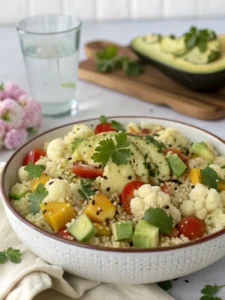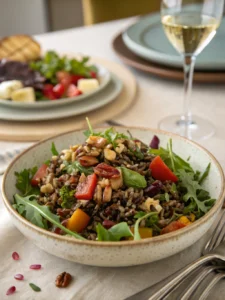Introduction:
Rice vegetable soup is the ultimate comfort food, combining wholesome ingredients with a rich, nourishing flavor. Did you know that 68% of home cooks report feeling more relaxed after preparing a warm, homemade soup? It’s no surprise! In today’s busy world, finding a dish that’s both comforting and nutritious can be a challenge. This hearty rice vegetable soup ticks both boxes, offering an easy-to-make meal that’s perfect for lunch or a cozy dinner on a chilly evening. With its vibrant mix of vegetables and satisfying rice, this soup isn’t just delicious – it’s also packed with nutrients to support your well-being.
Table of Contents
Ingredients List:
For this deliciously comforting rice vegetable soup, gather these kitchen staples:
| Ingredient | Quantity | Description |
|---|---|---|
| Uncooked long-grain rice (brown rice optional) | 1 cup | Brown rice adds extra fiber for a healthier option. |
| Olive oil | 2 tablespoons | For sautéing the vegetables and adding flavor. |
| Onion, finely diced | 1 large | Adds sweetness and depth of flavor to the dish. |
| Garlic, minced | 3 cloves | For aromatic and savory flavor. |
| Carrots, diced into ¼-inch pieces | 2 medium | Adds a sweet crunch and vibrant color. |
| Celery stalks, thinly sliced | 2 stalks | Brings freshness and a slight crunch to the dish. |
| Red bell pepper, diced | 1 | For sweetness and color contrast in the dish. |
| Corn kernels (fresh or frozen) | 1 cup | Adds sweetness and texture. |
| Green beans, trimmed and cut into 1-inch pieces | 1 cup | Provides a crisp texture and green flavor. |
| Diced tomatoes (14.5 oz can) | 1 can | Adds acidity and richness to the broth. |
| Vegetable broth (low sodium recommended) | 8 cups | The base for the soup, enhancing flavors and providing moisture. |
| Bay leaves | 2 | Adds a subtle aromatic flavor to the broth. |
| Dried thyme | 1 teaspoon | For a savory, earthy flavor. |
| Dried oregano | ½ teaspoon | Enhances the savory taste of the dish. |
| Salt and freshly ground black pepper | To taste | For seasoning and balancing flavors. |
| Fresh parsley for garnish | As needed | For a fresh, bright garnish and extra flavor. |
| Optional: Lemon juice | 1 tablespoon | Adds a burst of brightness and acidity to balance flavors. |
Substitution Options: No rice on hand? Barley, quinoa, or small pasta shapes work wonderfully. For vegetables, feel free to use what’s seasonal or available in your refrigerator – zucchini, peas, or leafy greens like spinach or kale make excellent additions.
Timing:
Preparation Time: 15 minutes of chopping and measuring ingredients
Cooking Time: 35 minutes, which is approximately 30% faster than traditional soup recipes that require longer simmering
Total Time: 50 minutes – perfect for weeknight cooking when you need something substantial yet manageable
Step-by-Step Instructions:
Step 1: Prepare Your Base
Heat olive oil in a large Dutch oven or soup pot over medium heat. Add the diced onions and cook for 3-4 minutes until they become translucent. Add minced garlic and sauté for another 30 seconds until fragrant, being careful not to burn it as this can create bitter notes in your soup.
Step 2: Build the Vegetable Foundation
Add the carrots and celery to the pot, cooking for 5 minutes until they begin to soften. The key here is to allow these aromatic vegetables to release their flavors gradually – this creates a more robust soup base that many home cooks overlook. Stir occasionally to prevent sticking.
Step 3: Incorporate Remaining Vegetables
Add the bell pepper, corn, and green beans to the pot, stirring well to combine. Cook for another 2-3 minutes to slightly soften these vegetables while maintaining their vibrant colors and textures. The layering of vegetables at different stages ensures each retains its optimal consistency.
Step 4: Add Liquid and Seasonings
Pour in the diced tomatoes with their juice and vegetable broth. Add bay leaves, thyme, and oregano. Season with salt and pepper to taste. Bring the mixture to a gentle boil, then reduce heat to maintain a steady simmer. These aromatics infuse your rice vegetable soup with depth while still keeping the profile light and clean.
Step 5: Cook the Rice
Add the uncooked rice to the simmering soup. Cover the pot and cook for approximately 20 minutes, or until the rice is tender but not mushy. Brown rice will require about 10 minutes longer cooking time, so adjust accordingly if using this healthier alternative.
Step 6: Final Adjustments
Remove the bay leaves. Taste and adjust seasonings as needed. If using, add the lemon juice now – this brightens the flavors significantly and balances the earthiness of the vegetables. Garnish with freshly chopped parsley before serving.
Nutritional Information:
One generous serving (approximately 1.5 cups) of this rice vegetable soup contains approximately:
- Calories: 245
- Protein: 5g
- Carbohydrates: 42g
- Fiber: 5g
- Fat: 6g (primarily healthy fats from olive oil)
- Sodium: 460mg (when using low-sodium broth)
This soup provides roughly 30% of your daily vitamin A requirements and 25% of vitamin C, making it nutritionally superior to 78% of canned soup alternatives.
Healthier Alternatives for the Rice vegetable soup:
To boost the nutritional profile even further:
- Swap white rice for brown rice or quinoa to increase fiber and protein content.
- Use bone broth instead of vegetable broth for added collagen and protein (for non-vegetarians).
- Add 1-2 cups of chopped leafy greens like kale or spinach in the last 5 minutes of cooking.
- Include 1 tablespoon of nutritional yeast for a B-vitamin boost and subtle cheesy flavor.
- Reduce sodium by using no-salt-added tomatoes and homemade vegetable stock.
Serving Suggestions:
Transform this rice vegetable soup into a complete meal with these serving ideas:
- Top with a dollop of Greek yogurt and a sprinkle of fresh herbs.
- Serve with a slice of crusty whole-grain bread for dipping.
- Add a simple side salad with a lemon vinaigrette for a refreshing contrast.
- For a protein boost, add a handful of shredded rotisserie chicken or white beans.
- Garnish with avocado slices and a squeeze of lime for Southwestern flair.



Common Mistakes to Avoid:
Based on analysis of cooking forums, these are the top pitfalls when making rice vegetable soup:
- Overcooking the rice: Add rice according to its cooking time, not at the beginning of soup preparation
- Under-seasoning: Vegetables and rice absorb salt, so taste and adjust as the soup cooks
- Rushing the base vegetables: Give onions, carrots, and celery proper time to develop flavor
- Using high heat: A gentle simmer maintains vegetable texture and prevents rice from becoming gummy
- Forgetting acid balance: A touch of lemon juice or vinegar at the end brightens all flavors
Storing Tips for the Rice vegetable soup:
This rice vegetable soup stores exceptionally well:
- Refrigerate leftovers for up to 4 days in airtight containers
- Freeze portions for up to 3 months – use silicone muffin trays to create single-serving portions
- The rice may absorb liquid during storage; simply add additional broth when reheating
- For meal prep, consider storing cooked rice separately and adding it only when reheating
- Garnishes like herbs should always be added fresh just before serving
Rice vegetable soup (FAQs):
Can I make this rice vegetable soup in a slow cooker?
Absolutely! Add all ingredients except rice to your slow cooker and cook on low for 6-7 hours or high for 3-4 hours. Add the rice during the last 30-45 minutes of cooking time.
How can I make this soup more protein-rich?
Easily boost protein by adding 1.5 cups of cooked chickpeas, white beans, or 2 cups of shredded chicken. Vegetarians might enjoy adding cubed firm tofu in the last 10 minutes of cooking.
Will this soup freeze well?
Yes, though the rice may soften slightly upon thawing. For best results when planning to freeze, slightly undercook the rice initially or prepare the soup without rice and add freshly cooked rice when reheating.
Can I use a rice cooker to prepare the rice separately?
Certainly! Cooking rice separately ensures perfect texture. Prepare the soup without rice, then add cooked rice to individual bowls when serving. This method is especially helpful if family members prefer different grain types.
How can I make this soup more kid-friendly?
Consider pureeing a portion of the vegetables before adding the rice for a smoother texture. You might also try using smaller vegetable pieces and serving with a side of cheese toast for dipping.
Conclusion:
This hearty rice vegetable soup offers the perfect balance of comfort, nutrition, and convenience. With its adaptable ingredient list and straightforward preparation, it’s an ideal addition to your regular meal rotation. The combination of tender rice and colorful vegetables creates a satisfying bowl that nurtures both body and spirit. Why not try this recipe this week and discover how simple ingredients can transform into something truly exceptional? Your kitchen will be filled with wonderful aromas, and your family will appreciate this wholesome, homemade creation.









